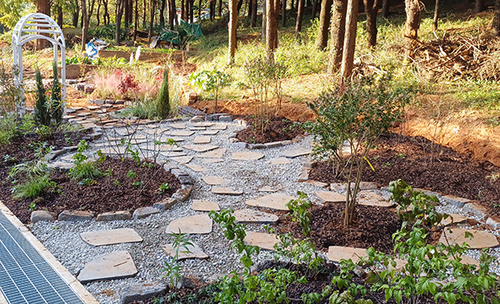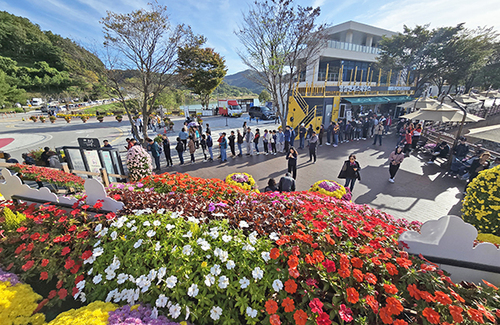| вЦ≤ нЫДл∞±м†ЬмЭШ мЧ≠мВђм†Б мЬДмГБмЭД мЮђм†Хл¶љнХШк≥† лђЄнЩФкґМ м†ХлєДмЭШ нЖ†лМАл•Љ лІИ놮нХ† мИШ мЮИлКФ кµ≠к∞А м∞®мЫРмЭШ л≤Х땆м†Б кЈЉк±∞мЭЄ 'мЧ≠мВђлђЄнЩФкґМ м†ХлєДл≤Х' мЭЉлґА к∞Ьм†ХмХИмЭі кµ≠нЪМ л≥ЄнЪМмЭШмЧРмДЬ мЭШк≤∞лРРлЛ§. (м†ДлґБ м†Дм£ЉмЛЬк∞А нЫДл∞±м†ЬмЭШ кґБмД± л∞П лПДмД±мЬЉл°Ь мґФм†ХлРШлКФ лЕЄмЖ°лПЩ лУ± кіАлВімЧР мВ∞мЮђнХі мЮИлКФ нЫДл∞±м†Ь мЬ†м†Бк≥Љ лђЄнЩФмЬ†мВ∞мЧР лМАнХЬ м†Хл∞АмІАнСЬм°∞мВђ к≤∞к≥Љл•Љ нЖ†лМАл°Ь мЩДмД±нХЬ лђЄнЩФмЬ†мВ∞ мЬ†м†БмІАлПД) / мВђмІД = лЄМл†ИмЭінБђлЙімК§ м†ДлґБмЈ®мЮђл≥ЄлґА DB © кєАнШДмҐЕ кЄ∞мЮР |
|
нЫДл∞±м†ЬмЭШ мЧ≠мВђм†Б мЬДмГБмЭД мЮђм†Хл¶љнХШк≥† лђЄнЩФкґМ м†ХлєДмЭШ нЖ†лМАл•Љ лІИ놮нХ† мИШ мЮИлКФ кµ≠к∞А м∞®мЫРмЭШ л≤Х땆м†Б кЈЉк±∞мЭЄ 'мЧ≠мВђлђЄнЩФкґМ м†ХлєДл≤Х' мЭЉлґА к∞Ьм†ХмХИмЭі кµ≠нЪМ л≥ЄнЪМмЭШмЧРмДЬ мЭШк≤∞лПЉ мШђк≥ІмЭі мЧ≠мВђк∞А л≥µмЫРлР† к≤ГмЬЉл°Ь кЄ∞лМАлРЬлЛ§.
м†ДлґБлПДлКФ "1,100мЧђлЕДм†Д к≥†лМАмВђмЭШ лІИмІАлІЙмЭД мЮ•мЛЭнХЬ лВШлЭЉмЭімЮР к∞АмЮ• к∞Х놕нХЬ кЄ∞мДЄл°Ь м∞ђлЮАнХЬ лђЄнЩФл•Љ кљГнФЉмЫ†лНШ нЫДл∞±м†ЬмЭШ мЧ≠мВђм†Б лђЄнЩФкґМмЭД м°∞л™ЕнХШкЄ∞ мЬДнХЬ мЧ≠мВђлђЄнЩФкґМ м†ХлєД лУ±мЧР кіАнХЬ нКєл≥Дл≤Х к∞Ьм†ХмХИмЭі кµ≠нЪМл•Љ нЖµк≥ЉнЦИлЛ§"к≥† 29мЭЉ л∞ЭнШФлЛ§.
нЫДл∞±м†ЬлКФ к≤ђнЫ§мЩХмЭі нЖµмЭЉмЛ†лЭЉ лІР нШЉлЮАкЄ∞мЧР 900лЕДмЧР м†Дм£Љл•Љ лПДмЭНмЬЉл°Ь мВЉмХД м§Скµ≠ мШ§мЫФкµ≠к≥Љ мЩЄкµРл•Љ мИШл¶љнХШлКФ лУ± кµ≠к∞Ам≤ік≥Дл•Љ к∞ЦмґФмЧИмЬЉл©∞ л∞±м†ЬмЭШ к≥ДмКємЭД л∞ФнГХмЬЉл°Ь мД±мЮ•нХЬ нЫДмВЉкµ≠мЛЬлМА кµ≠к∞А м§С нХШлВШлЛ§.
нКєнЮИ к≥†мЬ†нХЬ м†Хм≤імД±мЭД нШХмД±нЦИмЭМмЧРлПД мЛ†лЭЉмЧРмДЬ к≥†л†§л°Ь лДШмЦік∞АлКФ к≥ЉлПДкЄ∞м†Б кµ≠к∞Ал°Ь мЭЄмЛЭлПЉ к∞АмєШл•Љ м°∞л™ЕнХШк≥† мЭіл•Љ м≤ік≥Дм†БмЬЉл°Ь м†ХлєДнХі мІАмЧ≠л∞Ьм†ДмЭД лПДл™®нХ† мИШ мЮИлКФ кЈЉк±∞л≤Хл†ємЭЄ 'мЧ≠мВђлђЄнЩФкґМ м†ХлєДл≤Х'мЧР нПђнХ®лРШмІА л™їнЦИлЛ§.
нШДмЮђ нЫДл∞±м†Ь мЩХлПД м†Дм£Љл•Љ м§СмЛђмЬЉл°Ь м†ДлґБгЖНм†ДлВ®гЖНмґ©лґБгЖНмґ©лВ®гЖНк≤љлґБ лУ±мЧРмДЬ кіА놮 мЬ†м†БмЭі нЩХмЭЄлРШк≥† мЧ∞кµђ к≤∞к≥Љк∞А мґХм†БлРШл©імДЬ 'нЫДл∞±м†Ь мЧ≠мВђлђЄнЩФкґМ'мЭШ мЛ§м≤ік∞А нЩХмЭЄлРШк≥† мЮИлЛ§.
м†Дм£Љ 'лПЩк≥†мВ∞мД±'мЭА нЫДл∞±м†ЬмЧРмДЬ мВђмЪ©нХЬ к≥†к≥†нХЩм†Б мД±к≥Љк∞А нЩХмЭЄлРШлКФ лУ± мµЬкЈЉ 910лЕД нЫДл∞±м†ЬмЧР лІМлУ§мЦімІД 'лВ®мЫР мЛ§мГБмВђ нОЄмЪінЩФмГБ нГС'мЭА л≥ілђЉл°Ь мКєк≤©лРРлЛ§.
лШР 'лВ®к≥†мВ∞мД±'лВімЭШ мґФм†Х нЦЙкґБмІАмЧРмДЬлПД нЫДл∞±м†Ь лЛємЛЬмЧР мВђмЪ©лРРлНШ міИмДЭмЭілВШ кЄ∞лЛ®мДЭлУ§к≥Љ кЄ∞мЩАлУ§мЭі мИШмКµлПЉ нЫДл∞±м†Ь мЛЬлМАмЭШ мЬ†м†БмЭі м°імЮђнХ† к∞АлК•мД±мЭі мШИмЄ°лРЬлЛ§.
лШРнХЬ, мХДм§См†АмИШмІА мЭЄкЈЉ 'лђіл¶Йк≥†лґДкµ∞'мЭА мЭЄмЬДм†БмЬЉл°Ь лІМлУ† лМАнШХ лґДлђШнШХнГЬл°Ь м°∞мД±лПЉ мЮИлКФ лУ± мВ∞ м†ХмГБлґАмЧРмДЬ м†ХмЧ∞нХШк≤М л∞∞мЧілРЬ мИѓмЭі л∞Ьк≤ђлРРлЛ§лКФ м£ЉлѓЉлУ§мЭШ м†Ьл≥імЧР лФ∞лЭЉ нЦ•нЫД нЫДл∞±м†ЬмЩА мЧ∞кіАмД±мЧР лМАнХЬ кЄ∞лМАк∞РмЭі лЖТмХДмІАк≥† мЮИлЛ§.
мЭі л∞ЦмЧРлПД, мГЭмВ∞мЬ†м†БмЭЄ мЩЬлІЭмЛ§мЭШ мЪ∞мХДлПЩ мЩАмЪФмІАмЧРмДЬлПД мИШлІОмЭА кЄ∞мЩАнОЄк≥Љ к∞АлІИл≤љм≤інОЄ лУ±мЭі л∞Ьк≤ђлРРк≥† лД§л™® нШХнГЬмЭШ м†ДлПМнОЄ(кЄЄмЭі 25cm‧лСРкїШ 6cm)мЭі нЩХмЭЄлПЉ нЫДл∞±м†Ь кіАмХДмЛЬмД§мЧР нХДмЪФнХЬ кЄ∞мЩА л∞П м†ДлПМ лУ±мЭД к≥µкЄЙнЦИлНШ мІАмЧ≠мЭЉ к∞АлК•мД± мЧ≠мЛЬ м†ЬкЄ∞лРШк≥† мЮИлЛ§.
м†ДлґБлПД м≤ЬмД†лѓЄ лђЄнЩФм≤імЬ°кіАкіСкµ≠мЮ•мЭА "нЫДл∞±м†Ь мЧ≠мВђлђЄнЩФкґМмЭД лЛімЭА л≤Х땆мХИ к∞Ьм†ХмЬЉл°Ь кµ≠к∞А м∞®мЫРмЭШ нЫДл∞±м†Ь лђЄнЩФмЬ†мВ∞ м°∞мВђмЩА л∞Ькµі лУ±мЭі л≥Єк≤©м†БмЬЉл°Ь мЭіл§ДмІАл©і нЫДл∞±м†Ь мЧ≠мВђмЭШ м§СмЛђмЭімЧИлНШ м†ДлґБмЭШ мЧ≠мВђлђЄнЩФк∞А мШђк≥ІмЭі л≥µмЫРлПЉ лМАнХЬлѓЉкµ≠мЭШ м∞ђлЮАнХШк≥† мЬДлМАнХЬ мЧ≠мВђлђЄнЩФ м§С нХШлВШмЮДмЭД мЭЄмІАнХШлКФ к≥ДкЄ∞к∞А лР† мИШ мЮИлЛ§"к≥† м†ДлІЭнЦИлЛ§.
нХЬнОЄ, м†Дм£ЉлКФ нЫДмВЉкµ≠мЛЬлМА к≤©лПЩмЭШ м§СмЛђмЭімЮР м∞ђлЮАнХЬ мЧ≠мВђлђЄнЩФл•Љ нОЉм≥§лНШ нЫДл∞±м†ЬмЭШ мЧ≠мВђк∞А мЮ†лУ§мЦі мЮИлКФ к≥≥мЬЉл°Ь нЫДл∞±м†Ь мЩХлПД(зОЛйГљ)мШАлЛ§.
к≤ђнЫ§мЭі 900лЕДмЧР к±ікµ≠нХЬ нЫДл∞±м†ЬлКФ 935лЕД нЫДк≥Д лђЄм†Ьл°Ь мЮРмЛ†к≥Љ к∞ИлУ±мЭД лєЪмЭА мЮ•лВ® мЛ†к≤А(з•ЮеКТ)мЧР мЭШнХі кЄИмВ∞мВђ(йЗСе±±еѓЇ)мЧР к∞ЗнША мЮИлЛ§ лЛђмХДлВЬ мІА 1лЕД лТ§мЭЄ 936лЕД мЩХк±імЧР мЭШнХі л©ЄлІЭнЦИк≥† к≤ђнЫ§лПД кЈЄнХі мВђлІЭнЦИлЛ§.
лНФлґИмЦілѓЉм£ЉлЛє кєАмД±м£Љ(м†Дм£ЉмЛЬл≥С) мЭШмЫРмЭі 'м≤ЬлЕД к≥†лПД' м†Дм£Љл•Љ мЧ≠мВђгЖНлђЄнЩФ м§СмЛђ лПДмЛЬл°Ь лІМлУЬлКФ нХµмЛђ л≤ХмХИмЬЉл°Ь лМАнСЬ л∞ЬмЭШнХЬ 'мЧ≠мВђлђЄнЩФкґМ м†ХлєД лУ±мЧР кіАнХЬ нКєл≥Дл≤Х' мЭЉлґА к∞Ьм†ХмХИмЭі мІАлВЬ 9мЭЉ лђЄм≤імЬДгЖН27мЭЉ л≤ХмВђмЬДгЖН28мЭЉ кµ≠нЪМ л≥ЄнЪМмЭШмЧРмДЬ мµЬмҐЕ мЭШк≤∞лРРлЛ§.
вШЮ мХДлЮШлКФ мЬД кЄ∞мВђл•Љ кµђкЄА л≤ИмЧ≠мЭі л≤ИмЧ≠нХЬ мШБлђЄ кЄ∞мВђмЭШ 'м†ДлђЄ' мЮЕлЛИлЛ§.
кµђкЄА л≤ИмЧ≠мЭА мЭінХілПДл•Љ лЖТмЭікЄ∞ мЬДнХі лŪ놕нХШк≥† мЮИмЬЉл©∞ мШБлђЄ л≤ИмЧ≠мЧР мШ§л•Шк∞А мЮИмЭМмЭД м†Дм†Ьл°Ь нХ©лЛИлЛ§.
гАРBelow is the 'full text' of the English article translated by Google Translate.
Google Translate is working hard to improve understanding, and assumes that there are errors in the English translation.гАС
Amendment to the 'Special Act on the Maintenance of Historic and Cultural Areas' passed the National Assembly
Establishment of foundation for post-Baekje culture lightingвА¶ Rep. Kim Seong-joo, representative motion
Reporter Kim Hyun-jong
It is expected that history will be restored right away as some amendments to the 'Historical and Cultural Rights Maintenance Act', which is a national legal ground that can redefine the historical status of Later Baekje and lay the foundation for the maintenance of cultural rights, will be passed at the plenary session of the National Assembly.
Jeonbuk-do announced on the 29th that "an amendment to the special law on the maintenance of historical and cultural rights to shed light on the historical and cultural rights of Later Baekje, a country that marked the end of ancient history more than 1,100 years ago and flourished with the most powerful momentum, passed the National Assembly."
Later Baekje is one of the countries of the Later Three Kingdoms Period that developed based on the succession of Baekje, with a national system established by King Gyeon Hwon, who made Jeonju his capital in 900 during the chaotic period at the end of Unified Silla and established diplomatic relations with China's Oyue.
In particular, even though it formed its own identity, it was recognized as a transitional country from Silla to Goryeo, so it was not included in the 'Historical and Cultural Rights Maintenance Act', which is the basis for promoting regional development by illuminating values and systematically reorganizing them.
Currently, the substance of the 'Historical and Cultural Sphere of Later Baekje' is confirmed as related remains are confirmed in Jeonju, the capital of Later Baekje, and research results are accumulated in Jeonbuk, Jeonnam, Chungbuk, Chungnam, and Gyeongbuk.
Jeonju's 'Donggosanseong Fortress' has been confirmed as an archaeological result used in Later Baekje, and recently, 'Namwon Silsangsa Pyununhwasang Pagoda' built in Later Baekje in 910 was promoted to treasure.
In addition, in the presumed haenggung site in 'Namgosanseong', foundation stones, stylobate stones, and roof tiles used during the Later Baekje period were collected, and it is predicted that the remains of the Later Baekje period exist.
In addition, 'Mureung Ancient Tombs' near Ajung Reservoir are built in the form of artificially large tombs, and as residents reported that charcoal was found in an orderly arrangement at the top of the mountain, expectations for a connection with Later Baekje are rising.
In addition, numerous pieces of roof tiles and pieces of kiln walls were found in Wayoji, Wayoji, Waemansil, a production site, and square-shaped brick pieces (length 25 cm, thickness 6 cm) were confirmed. The possibility of being local is also being raised.
Cheon Seon-mi, director of the Culture, Sports and Tourism Bureau of Jeonbuk-do, said, вАЬIf the national level of post-Baekje cultural heritage research and excavation is carried out in earnest through the revision of the bill that includes the post-Baekje historical and cultural sphere, the history and culture of Jeonbuk, which was the center of post-Baekje history, will be restored and the Republic of Korea will be splendid. It can be an opportunity to recognize that it is one of the great historical cultures."
On the other hand, Jeonju was the royal capital of Later Baekje, the center of turbulence during the Later Three Kingdoms period, and the place where the history of Later Baekje, which spread its splendid history and culture, is asleep.
Later Baekje, founded by Gyeon Hwon in 900, was imprisoned in Geumsansa Temple by his eldest son, Shin-geom, who had a conflict with him over the issue of succession in 935. did.
Some amendments to the 'Special Act on the Maintenance of Historical and Cultural Areas', which was proposed as a key bill by Rep. Kim Seong-joo(Jeonju Army) of the Democratic Party of Korea as a key bill to make Jeonju a city centered on history and culture, on the 9th and 27th, the Judiciary Committee and 28th The final decision was made in the plenary session of the National Assembly.




 мї§лЃ§лЛИнЛ∞
мї§лЃ§лЛИнЛ∞  нФЉнФМ
нФЉнФМ  лПЕмЮРнИђк≥†
лПЕмЮРнИђк≥†
















 лІОмЭі л≥Є лЙімК§
лІОмЭі л≥Є лЙімК§











